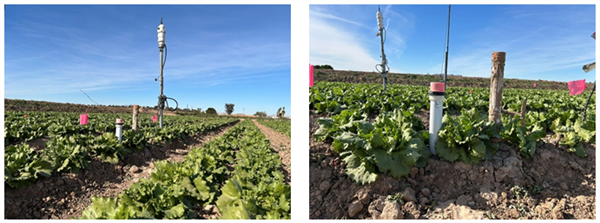Both organic and conventional lettuce are high-demand crops for nitrogen, with organic lettuce requiring organic nitrogen and conventional lettuce requiring general nitrogen sources. Lettuce requires a substantial amount of nitrogen to support its growth, particularly during the heading stage when most nitrogen uptake occurs. This demand is driven by its rapid growth rate and the production of large leaf biomass.
Organic nitrogen/nitrogen management for lettuce production in Yuma, Arizona, is acritical aspect of efficient and sustainable agriculture. Proper nutrition(organic nitrogen or nitrogen) management can improve crop yield, reduce environmental impact, and optimize resource use. This is significantly correlated with sufficient soil moisture availability. As a result, improper or excessive water and nutrient management for both organic and conventional lettuce production systems could significantly and negatively impact growth, development, and yield quality.
Moreover, several studies have reported that proper water and nitrogen management could potentially reduce aphid attraction to lettuce, as aphids are more prevalent in lettuce with higher nitrogen content. Elevated nitrogen levels in lettuce can attract and support larger aphid populations.
There are many approaches that could be adopted for coupled water and nutrient management, or in other words, best management practices to avoid excessive or inadequate application of either element. After soil sample analysis in the pre-season, one of these approaches involves utilizing high-tech site-specific sensors, which can be installed between two healthy plants that represent the majority of the field to monitor nitrate-N levels in the soil throughout the growing season. These sensors monitor nitrate-N levels on a daily or weekly basis to evaluate nutrient levels at different soil profile depths, especially during critical lettuce growth stages. Many studies have reported that site-specific, sensor-based nutrient management increases efficiency compared to traditional methods, resulting in significant nitrogen savings.
Preliminary results from ongoing research comparing nutrient levels by utilizing AquaSpy Nitrate sensor (Figures 1. 2. And 3) with soil analysis conducted in the lab (Ward Laboratories Inc.) as part of the study on organic vs. conventional iceberg lettuce under subsurface drip irrigation at the Yuma Ag Center-Valley Research Center, suggest that the findings are comparable to a considerable extent so far. Soil moisture availability and soil temperature fluctuations significantly influence the data reflected by the sensors, particularly at varying profile depths. This is an ongoing project; however, the results are promising regarding the aforementioned objectives in organic and conventional lettuce production systems. Stay tuned for the results and conclusions after harvesting.

Figure 1. Nitrate sensor from AquaSpy was installed between two healthy plants in the
organic lettuce production field at the Valley Research Center at the University of
Arizona, Yuma Agricultural Center, Yuma, Arizona.

Figure 2. Nitrate level in the conventional lettuce production field at the Valley Research
Center at the University of Arizona, Yuma Agricultural Center, Yuma, Arizona.







